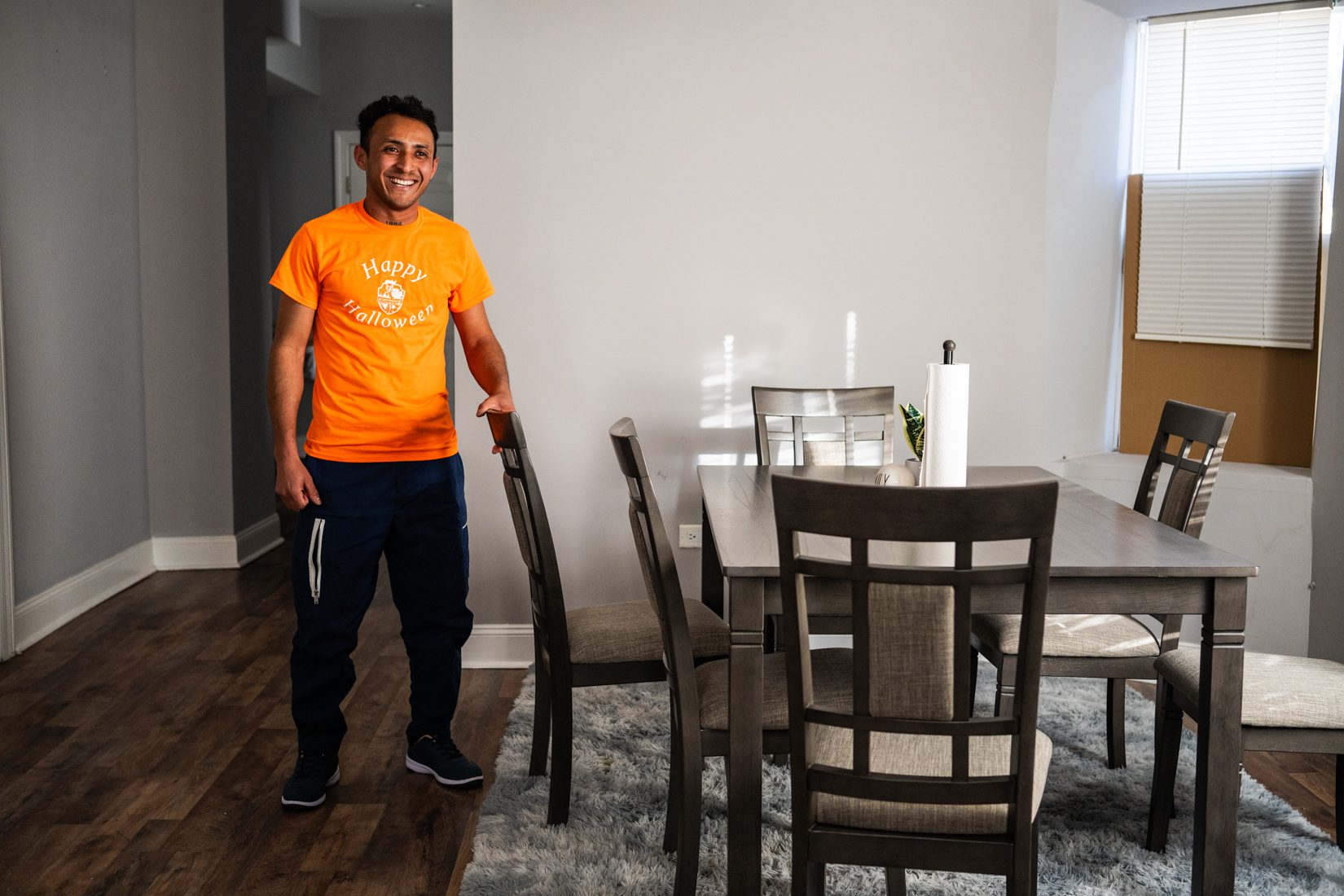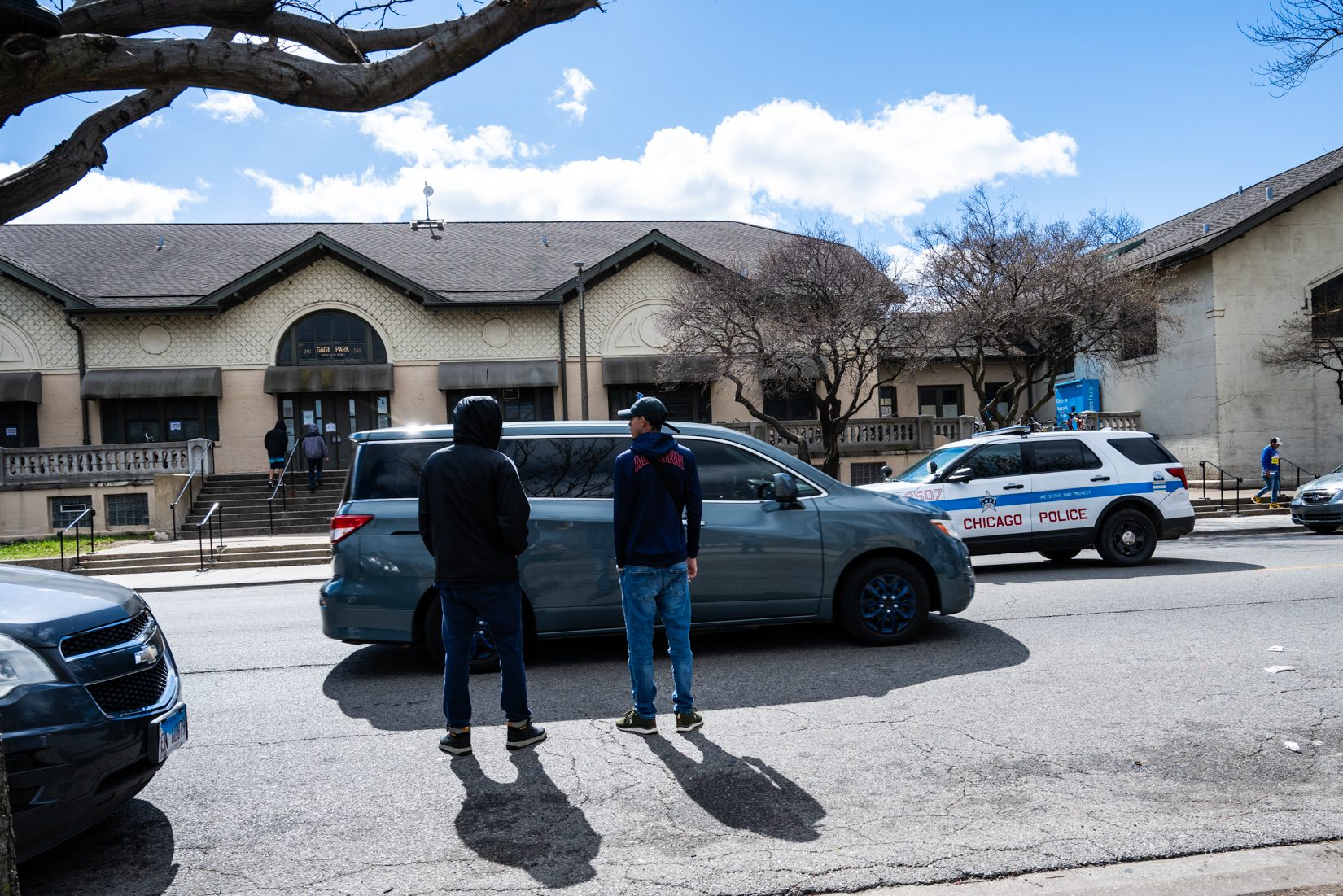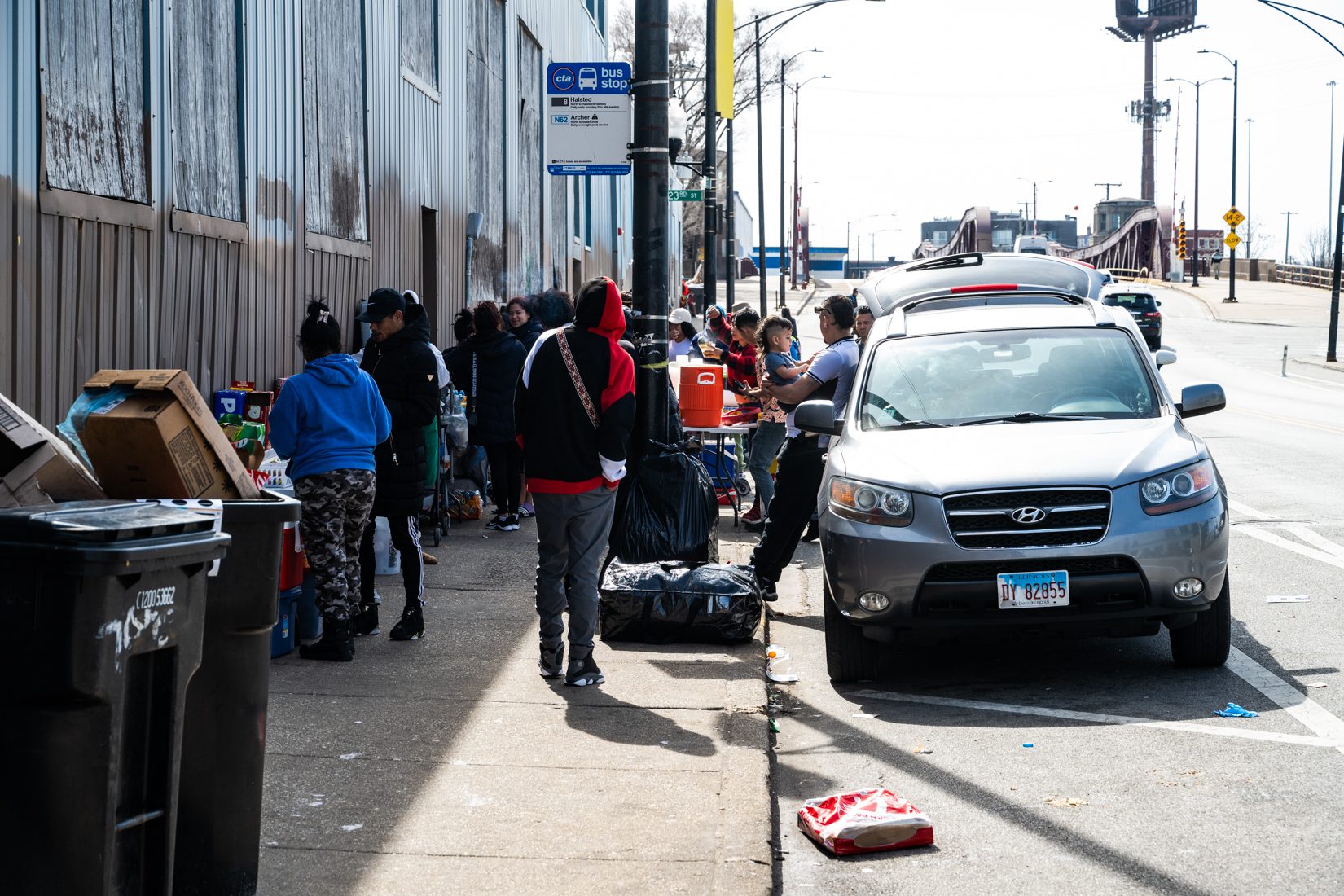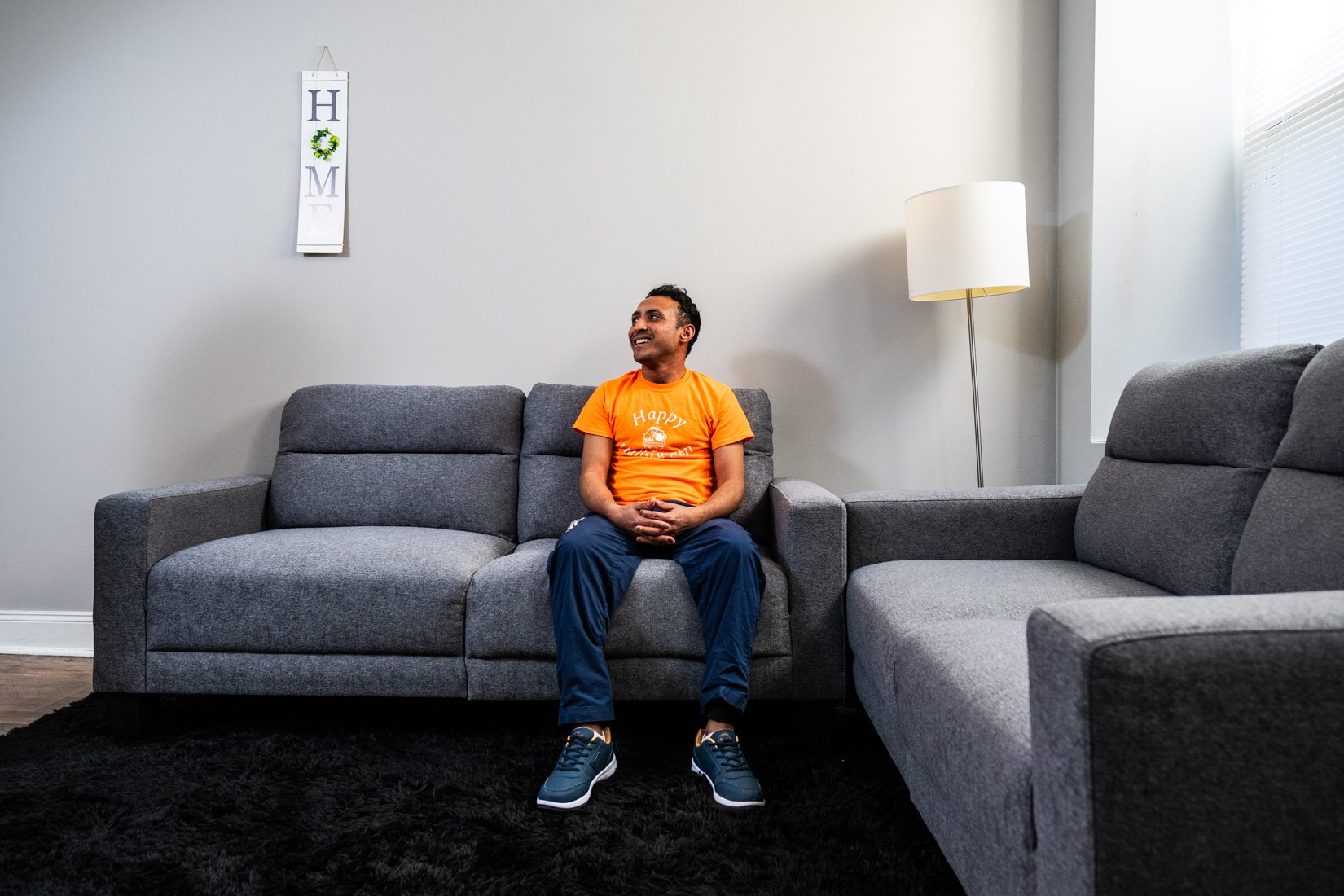 Colin Boyle/Block Club Chicago
Colin Boyle/Block Club ChicagoThe Asylum Seeker Emergency Rental Assistance Program has helped 4,600 households move into apartments. But some migrants supported by the program could lose their homes if they can’t find work.
This story was produced in collaboration with Block Club Chicago, a nonprofit newsroom focused on Chicago’s neighborhoods.
CHICAGO — On the Far South Side, sunlight streamed into the west-facing windows of Edwin’s apartment as he remembered his months-long journey from Venezuela.
“It was difficult, I won’t deny,” said Edwin, who asked not to use his last name.
Edwin left his home country facing discrimination because of his sexuality and as Venezuela struggled with political upheaval, an economic crisis, rising unemployment and violent crime.
Want to receive stories like this in your inbox every week?
Sign up for our free newsletter.

The young asylum seeker moved into his home in December after briefly staying in a city-run shelter. He shares a two-bedroom, one-bathroom garden apartment with three friends who are also migrants. There’s a gray couch, a plush rug and, a moderately sized TV in the living room. There’s even a large side yard, which the landlord told Edwin they are welcome to use.
Edwin and his roommates are among the last of newly arrived migrants who were eligible for six months of emergency rental assistance thanks to a program that helped them leave the city-run shelter system.
The Asylum Seeker Emergency Rental Assistance Program has helped about 4,600 households move out of shelters and into apartments since December 2022. Local leaders have heralded it as a critical state program to find alternative housing and support the city’s ability to absorb thousands of migrants arriving in Illinois since 2022.
But amid federal backlogs for work permits and asylum applications, volunteers have criticized the state program for being too slow to process applications and cutting off support too early for new arrivals trying to establish stability and independence.
Some migrants supported by the program could be forced back onto the streets or into city-run shelters if they aren’t able to find work before their rental assistance dries up.
And state officials aren’t tracking how many people are forced to move out if they can’t pay rent.
The state “hasn’t seen a trend of residents losing their housing,” said Daisy Contreras, Illinois Department of Human Services spokeswoman. But she confirmed the state isn’t keeping tabs on people successfully continuing their leases.
“There have been instances of people leaving or moving, but the state does not track why or when residents leave on their own accord,” Contreras said in an email.
In a recent press briefing, Brandie Knazze, Chicago Department of Family and Support Services commissioner, also said the city isn’t seeing a trend of people needing to return to shelters after rental assistance runs out.

For Edwin, the emergency assistance and the move into the apartment marked the closing of a significant chapter in a perilous journey that began last summer.
The apartment has provided peace and the ability to start over. But his mind drifts to June, when his support will run out. He’s worried whether he and his roommates will be able to make rent, especially as most of them search for jobs.
“I heard that they only give the six months — from here on, there’s no more benefits,” he said.
Read More of Our Coverage
‘We Won’t Be Able To Continue Without Federal Support’
In August 2022, Gov. JB Pritzker issued a disaster proclamation allocating resources for emergency shelter, medical care and transportation to support migrants arriving in Chicago from Texas and other southern border states.
Among the resources provided to migrants was the rental assistance program, run by the Illinois Housing Development Authority in partnership with the Illinois Department of Human Services, which initially covered six months of rent, or $15,000 per housing agreement.
But in mid-November, the state capped its policy, limiting rental assistance to three months for migrants who arrived in the city’s shelters before Nov. 17, 2023.
Capping the length of assistance was to ensure everyone in city shelters at the time could access the rental assistance program, according to Pritzker’s office. But the revamped program excluded thousands of migrants who arrived after the cutoff date.
Soon, thousands more will lose eligibility if they are evicted as part of the city’s 60-day shelter stay limit, which kicked in Saturday.

The policy change also directed millions of dollars toward migrant resettlement and case management. The money funded an “intake center” at the city’s landing zone and legal services to help with work permit processing for new arrivals.
Illinois has spent $45 million on its rental assistance program — about 80% of the program’s total budget — as of late February, according to state officials.
The rental assistance program “is federally funded, and we won’t be able to continue without federal support,” Contreras said. “Regardless, state-funded shelter and legal assistance will continue.”
Despite the state’s effort to streamline support, volunteers have said many migrants are falling through the cracks because there aren’t enough caseworkers or state officials in shelters to process applications quickly.
As part of the settlement process, each city-run shelter is supposed to provide onsite case management from Catholic Charities and the state’s Housing Stability Service to approve rental assistance applications and locate housing. But more than a year after being rolled out, many shelters had few caseworkers to process applications and not enough Catholic Charities case managers to help people find available housing.
There weren’t Catholic Charities case managers in some of the city’s shelters until the end of January, said Daniel Castañeda, director of new arrivals for the city’s Department of Family and Support Services.
Even at shelters with representatives to support rental assistance applications, volunteers and case managers said there weren’t enough people to help thousands of migrants complete the application.
Inside the Gage Park migrant shelter, only one Housing Stability Service caseworker was approving rental assistance program applications until mid-November for a shelter that currently houses 350 migrants, said Karla Lopez, a Brighton Park Neighborhood Council program manager. The caseworker could only process as few as five applications daily, she said.
After the three-month rental assistance cap was announced, Lopez and other Brighton Park Neighborhood Council caseworkers worked through the weekend to help residents file their applications before the changes would take effect. But with no Housing Stability Service caseworkers around, those applications weren’t processed, and many families lost out on six months of help, Lopez said.
“Too many” families fell through the cracks, she said.
“We were working so hard on the weekend to make sure we find the apartments — we were texting with the landlords, we were visiting some apartments to check it out,” Lopez said. “We were doing our job. And nobody [from the Rental Assistance Program] was here.”

Volunteers step up to help amid gaps in state resources
Chicagoans have stepped up to provide new arrivals with housing options, resources and support throughout the city. Volunteers have become de-facto real estate agents amid a shortage of caseworkers with steep caseloads, said Erika Villegas, a real estate agent who volunteers to help new arrivals on the Southwest Side.
Villegas has had the most luck with small “mom-and-pop” landlords willing to take in migrant families with limited job prospects.
“We’re trying to tell migrants to stay in shelters as long as they can, use the food pantries, save up, so we can then go to landlords and say: ‘These people are working. They have some savings. Can you get them in?’” Villegas said.
Villegas also rents to a migrant family she met at a police station. The family has struggled to make rent, and Villegas is figuring out what works best for them.
“We’re working out a payment plan,” Villegas said. “Does it make sense for them to pay a little bit every week instead of monthly? I’m trying to be flexible with tenants given what they have.”
Volunteers have noted that affordable housing is scarce, and migrants face a lot of skepticism from landlords who don’t want to rent to migrants who only have three months’ rent and few job prospects.
Read More of Our Coverage
In September, President Joe Biden’s administration expanded the Temporary Protected Status designation for Venezuelans who arrived in the United States before July 31, opening the door for thousands of Venezuelan immigrants in Chicago to apply for deportation protection and work permits.
While Temporary Protected Status would grant temporary protection from deportation, the program does not provide a pathway to citizenship for applicants. Those who apply for the status face steep application fees and backlogs in the immigration process, meaning it could be months before their applications go through the system. Without applying for Temporary Protected Status or other immigration protections however, migrants cannot get work permits — which also means they’d have no money to pay for rent.
“Sometimes they say that when you go into the U.S., there will be a lot of opportunities to work and to own things,” one migrant previously told Borderless Magazine. “But I cannot work if I don’t have a permit, and everywhere I go, they ask for it.”
‘We’re Not Giving People Enough Time To Become Independent’
With some residents approaching the end of their six months of rental assistance, volunteers and advocates like Villegas have been raising alarms that some families might have to return to shelters or face homelessness.
“We’re not giving people enough time to become independent. The program lets people get out of the shelter system, but then they’re on their own, and it becomes their own fault if they can’t figure it out,” Villegas said.
While the emergency rental program has helped many families out of shelters and into homes, housing for migrants remains precarious amid a limit on rental assistance and a backlog in federal work permits, volunteers said.
“If we truly want to invest in people, we can’t leave them with this anxiety that they’ll need to move again so quickly, change communities again, displace their kids again from schools,” Villegas said. “It’s a whole, big cycle.”
It could be devastating if housing gets taken away as people try to get settled, Villegas said.
Asked about calls to restore assistance to six months, Pritzker said on Wednesday that some of the $250 million funds pledged by the state and county would “of course go” toward the program.
“It’s a comprehensive program. These are basic needs. We are trying to cover the needs,” Pritzker said.
Charlotte Long, a housing specialist connecting migrants with apartments and rental assistance through Sanctuary Working Group, said the three-month rental assistance program deterred one of the landlords she spoke to from wanting to house migrants. He didn’t want to go through the costly process of evicting them later if they couldn’t afford their rent.
Three months “is such a short amount of time,” Long said.
Long has tried to find apartments for migrants in Spanish-speaking neighborhoods and near public transportation so they’ll be able to navigate the city well and create support systems.
“Even if they just know one or two of their neighbors, and they can speak in Spanish to them, it’s a huge, huge benefit,” Long said. “These are forms of cutting through the very real isolation that every family is going to feel when they get here.”

Over the past few months, Edwin and his roommates have been settling into their home on the Far South Side despite the challenges they’ve faced living far from the CTA and without a Spanish-speaking community. Being on his own outside a city-run shelter has given him a sense of autonomy and privacy to start his life here.
“I love the house; it’s beautiful,” he said.
Edwin said it’s often difficult trying to communicate with English speakers where he lives, so he typically leaves the neighborhood when he needs to shop.
“There’s some people who very kindly help as a translator, but there are others that respond very badly,” he said.
Looking ahead, the Venezuelan sees a future for himself in Chicago — maybe near Little Village’s 26th Street, a historical port of entry for Latino immigrants in the city.
“There are so many people here who support us, who want to help us,” Edwin said. “I say, ‘Why would I close this opportunity to go somewhere else and start from zero again?’”

Bring power to immigrant voices!
Our work is made possible thanks to donations from people like you. Support high-quality reporting by making a tax-deductible donation today.


